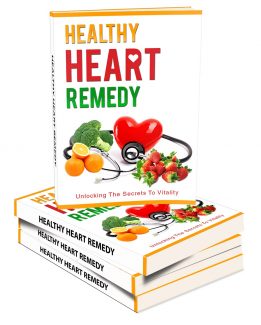 License Type: Master Resell Rights
License Type: Master Resell Rights  File Type: ZIP
File Type: ZIP
 SKU: 60605
SKU: 60605  Shipping: Online Download
Shipping: Online Download
Sample Content Preview
Introduction
Heart attacks are one of the leading causes of death in America. With most of us suffering from various kinds of health conditions and adding a lot of extra stress to the heart through our lack of activity and poor eating habits, it is no wonder that many of us are just ticking time bombs before we are able to experience a heart attack ourselves.
Mother Nature has taken hundreds of thousands of years of evolution to develop your heart along with the rest of your body.
Perfected by nature to become arguably the most important organ in your body. Your heart is a large muscle that pumps blood containing oxygen and other essential substances to all the organs and cells of the body. Not just that, it provides the means of removing the waste that is produced by day to day bodily functions.
This guidebook is going to spend some time looking at the various aspects of heart disease and heart attacks. You'll learn everything you need to know about heart attacks, some of the complications that arise from these, and even the risk factors that will make it more likely that you will suffer from a heart attack at some point. But the good news is there are plenty that you can do to help reduce the likelihood of the heart attack, and you just need to get started as soon as possible. In this guidebook, we are going to explore some of the things that you can do in order to keep your heart healthy and to feel good in no time.
Everyone wants to make sure that they have a strong heart and live a long, healthy life. When you are ready to prevent against heart attacks and feel as good as possible, make sure that you check out this guidebook and learn the steps that you should take to finally see results and keep your heart strong.
Part One
All about Heart Attacks
Chapter 1: What is a Heart Attack or
Myocardial Infarction?
Heart attack occurs when there's death or necrosis of a segment of heart muscle due to the loss of blood supply. The blood supply is usually lost due to blocked coronary artery, one that provides blood to the heart muscle by blood clots. This condition is also known as coronary thrombosis.
When it happens, one will experience distressing symptoms such as chest pain and electrical instability of the myocardial tissues. Heart disease is a very general term used to describe all the different disorders and diseases that can affect your heart and its operation. One of the most common causes is oxygen starvation; this is usually the result of a blockage in the arteries that carry the flow of oxygenrich blood from the lungs to the heart. This condition can lead to heart damage and if left untreated, the damaged heart will undergo necrosis. In other words, the heart cells will start to die. Often times, this condition is caused by a buildup of a waxy substance known as plaque.
As plaque builds up inside your arteries, it can result in the coronary (or heart) arteries being partially or totally blocked. This condition is known as atherosclerosis. This will restrict blood flow to your organs and tissues. If this condition is not treated quickly, the areas of the heart that rely on this artery will die. The once healthy heart tissues will also undergo fibrosis, forming scars that impede the usual functions of the heart. Sometimes, such condition will go off radar and difficult to be discovered. So if you leave it as it is for a long time, many heart health problems will arise in the long-term.
Symptoms of a Heart Attack or MI
With so many people suffering from heart attacks, many people are looking for ways in order to prevent these heart attacks. But before that, we should learn the early warning signs and symptoms of a heart attack or MI.
The symptoms of a heart attack can vary widely. For instance, you may have only minor chest pain while some else has excruciating pain.
Some typical heart attack symptoms for men and women are:
Feeling of heaviness, pain, pressure, and even discomfort inside of the chest, below the breastbone, or in the arm.
Discomfort that radiates to the back, arm, throat, or jaw.
Feeling indigestion, fullness, and even a choking feeling. Itmay feel like heartburn sometimes.
Dizziness, vomiting, nausea, and sweating.
Extreme shortness of breath, anxiety, or weakness.
Collapse or lose consciousness.
How to Diagnose a Heart Attack or MI?
There are thousands of people every year who fall prey to heart attacks without even realizing that they have it in the first place. They act as if nothing has happened because most who had early stages of heart attacks are asymptomatic until the crisis happens. Think of it as a walking time bomb. To identify any diseases, we look at the symptoms a person is suffering from. Such symptoms for heart attack
differs from one person to another. They can be mild or grave. Also, the severity and susceptibility of contracting the disease depend on the age, sex, presence of risk factors or underlying diseases. For instance, those who have diabetes usually demonstrate subtle or unusual symptoms.
In any case, if you find yourself suffering from any heart attack symptoms, you must get emergency treatment immediately. The speed of treatment is of utmost importance when dealing with episodes of heart attacks. In fact, the faster the emergency treatment, the higher the chance of survival.
When you're having an attack, bear in mind to seek help from others. Do not attempt to drive or walk yourself to the hospital when you're in excruciating pain as you'll only exacerbate the symptoms and inviting further complications. Get someone to call for an ambulance and seek prompt medical attention. Every second counts and by seeking early medical care, you can prevent further injuries to your heart tissues and even stay alive!
Chest Pain – Cardiogenic VS Non-Cardiogenic
Most people experience chest pain to some degree, at one time or another over the course of their lives. This is often caused by anxiety because chest pain is so often associated with heart disease. Fortunately, almost all chest pain has little to do with the heart, but it is not something you should ignore.
Understanding the difference between the different types of chest pain helps in diagnosing heart diseases. Pain in the left part of the chest is one of the earliest signs a person can have to pinpoint the disease. The next step is to determine whether the pain originates from the heart or other factors.
The chest and lung areas are made up of many different structures all of which can produce pain. The most common type of pain or tenderness is in the muscles and bone joints around the chest. The lining or pleura around the lungs can be associated with pain if it becomes inflamed or irritated, but the lungs do not contain any of the nerve connections that will induce the feelings of pain.
The esoph agus or the tube from your mouth to your stomach is another area in your chest that can give you pain. Heartburn, as it is often referred to or refluxing has nothing to do with your heart, but can often give a pain that feels like a heart disorder. The esophagus can also have or give spasms, which is also noncardiogenic. Cardiac or heart-related chest pain is more often experienced in the morning. Symptoms include a dull, constricted pressure with burning or squeezing sensation. Instead of superficial pain, people usually find that the pain comes from the deeper areas of their chest. However, it can be difficult when it comes to describing the location of the pain.
It may feel like the pain originates from all areas such as back, neck, head, and throat or even from the arms (often the left upper arm). Not knowing where the pain comes from, people commonly described that "the pain came out of nowhere." Chest pain is often brought on by some form of exertion like carrying a heavy bag, sweeping or digging.
Extreme temperature while exercising or working can also cause a heart attack. It can also follow after eating a heavy meal, then doing physical work. These types of pain usually last as long as the physical activity you are doing continues, but in most cases reduces quite quickly once the activity that brought it on is stopped.








